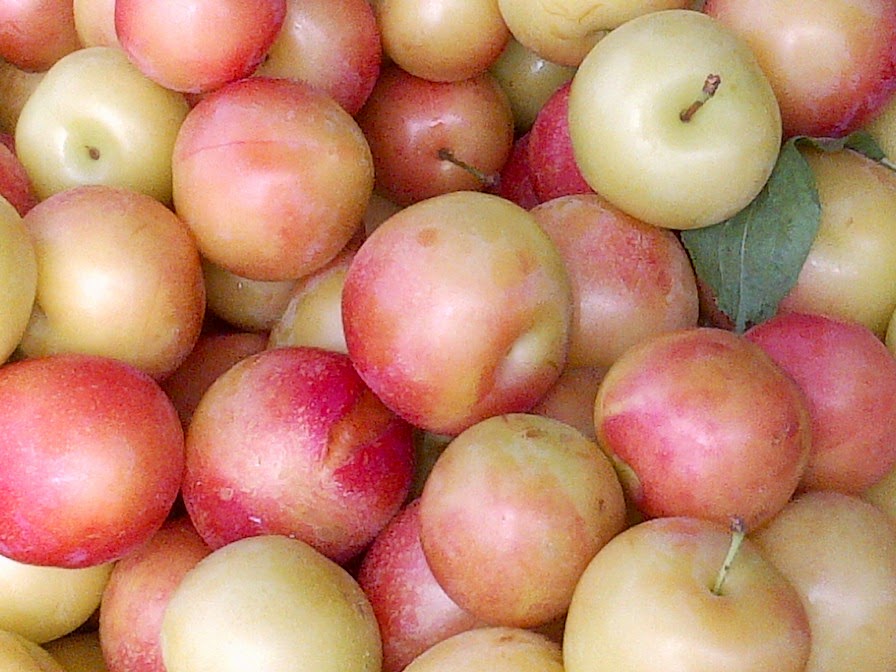Plums, on the other hand, continue to stump me.
I understand a few varieties, especially the Empress and Prune - the oval ones with purple skins and greenish-brown flesh. When I was young, the sightings of prune plums always made me sad, since they signified the end of summer and the imminent return to school. Nowadays they appear in July, breaking the poignant end-of-summer-freedom association. I'm not a big fan of these plums, but I appreciate their intelligible code: hard plums will be tart, soft ones sweeter, and their flesh predictable along the green-brown spectrum.
But "black" or "red" plums are another story. Will their flesh be pink-red -- or beige? Plums with similar purple-black skin can look nothing alike when cut.
Markets that meticulously describe their produce often still use these crude color terms to identify their plums.

I turned to the International Federation for Produce Standards PLU (Produce Look Up) Codes on the plums' stickers for salvation.
Not much help! The code 4040, for example, just signifies "Large Black Plum."
This "includes Ambra, Black Beaut, Prima Black, Blackamber, Black Torch, Catalina, Challenger, Black Diamond, Friar, Royal Diamond, Black Knight, Freedom, Black Flame, Howard Sun and Angeleno." This range means that the plums labeled #4040, the most common number I've seen, can vary from squat to heart-shaped and can have interior flesh of pretty much any possible plum color: dark magenta, beige, pale pink. More importantly, #4040 plums can have any degree of flavor. Likewise, Code 4042 indicates "Large Red Plum," with another wide range of varieties (including ones I actually am familiar with, like Santa Rosa and Fortune).
Three of the stickers featured a cute dinosaur, which is a trademark of Dinosaur Brand pluots. A few years ago NPR claimed that pluots, the plum-apricot hybrids, "now make up a majority of the plum market. In fact, you might be eating a pluot or an aprium [another plum-apricot hybrid] and not even know it." Based upon my sticker survey, with many more #4040s than any other number, that isn't true. Using the International Federation for Produce Standards PLU website tells you about as little about the pluots as it does for plums: PLU 3278 is "Mottled Pluot" whereas 3609 is "CA Red Pluot." But since pluots and plumcots, pluots' plummier cousins, are relatively recent hybrids, breeders are interested in their distinctions. I wouldn't mind a chart for plums as comprehensive as this handy-dandy one for pluots!
Of course, many markets sell farm fresh plums, free from any PLU sticker adornment. The Union Square Greenmarket leans heavily toward plums round and small, like Shiro and Methley, which they sometimes call Sugar Plums. Of course, "sugar plums" usually refers to a confection of dried fruit, ground almonds and lots of sugar -- adding to the confusion that surrounds plums.
So what to do with the mystery of the plum? I'd say relax and enjoy its unpredictability. And with that, I'll salute the plum, in all of its diverse beauty and mystery.

















THANK YOU for your interesting article. I too have been curious about which plum I am buying or which one I am getting ready to bite into. Earlier today I did a google search on "3609 plum" and among the hits I found a website that lists a whole bunch of codes. The website is Kingsburg Orchards and I presume they grow a lot of these fruits. I have not taken the time to delve deeper to see what else they offer in the way of information but I think you might be interested in it if you have not already discovered it. The variety of stone fruits and hybrids is amazing.
ReplyDeleteTHANK YOU for your interesting article. I too have been curious about which plum I am buying or which one I am getting ready to bite into. Earlier today I did a google search on "3609 plum" and among the hits I found a website that lists a whole bunch of codes. The website is Kingsburg Orchards and I presume they grow a lot of these fruits. I have not taken the time to delve deeper to see what else they offer in the way of information but I think you might be interested in it if you have not already discovered it. The variety of stone fruits and hybrids is amazing.
ReplyDeleteThis was absolutely awesome!! I googled 4042 and ended up reading your lovely article. Plums have been my favorite fruit since I was a kid.
ReplyDeleteI never knew there were so many different types.
Thank you for the lesson!!!!
Thanks i had 3278 n wanted to know what it was iused goole n ran into your article really loved it i think we will take your advice n just enjoy such a great fruit again thanks b bless
ReplyDeleteYour article was great. I had eaten
ReplyDeletea few pieces of fruit.I wasn't sure
it was a plum until I researched the
# 4042. Your info on the Kingsbury artical was very helpful. Thank You
4042s are consistently delicious before August. After that, they seem to have been frozen.
ReplyDeletedreas
ReplyDeletedres
ReplyDelete